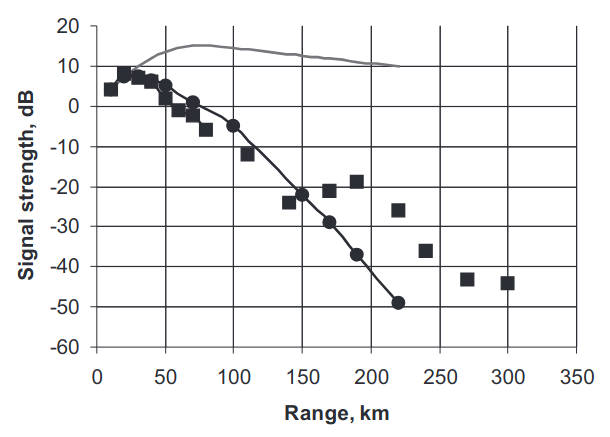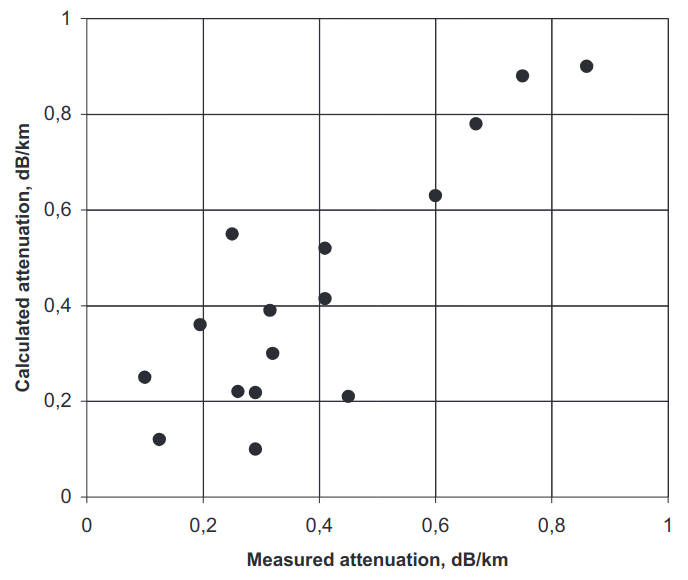Dive into the study of coherence function in random and non-uniform atmospheres. This article examines the approximate extraction of eigenwaves from the discrete spectrum, particularly in the context of evaporation ducts.
Learn about the essential equations that define the coherence function and their significance in atmospheric research and applications. Perfect for researchers and enthusiasts in the field of atmospheric science.
Approximate Extraction of the Eigenwave of the Discrete Spectrum in the Presence of an Evaporation Duct
Consider Green Function for a Parabolic Equation in a Stratified Mediumthis equation in the case when the evaporation duct is present in the height interval (0, Hs). Let us seek a solution to the attenuation function W in the expansion over the system of eigenfunctions of the continuous spectrum defined in Understanding Parabolic Approximation in Wave Propagation: Analytical Methods and Applications“Parabolic Approximation to a Wave Equation in a Stratified Troposphere Filled with Turbulent Fluctuations of the Refractive Index”.
Such poles correspond to waves trapped in the waveguide channel created by the evaporation duct. Without loss of generality we consider here the situation when N = 1, i. e. a single mode waveguide (evaporation duct). It is the most common case for the evaporation duct propagation of radio waves in a range of about 10 GHz.
Let us split the interval of the integration in Spectrum of Normal Waves in an Evaporation DuctEquation into two domains and set W = W1 + W2 where:
and Em = k2(εm(Hs)-1). Using Eq. (2) we can evaluate the contribution of the term W1. In the shadow region:
where z, z0 are the heights of the transmitting and receiving antennas respectively, the major contribution to the integral (Spectrum of Normal Waves in an Evaporation Ductequation) comes from the E-interval k2(εm(Hs)-1) < E < k2(εm(0)-1) and the height interval z < Hs:
Within the interval Em < E < E0 we can distinguish a function , which depends little on E:
and normalised by the following equation:
Using Eq. (5) the term W1 is given by:
Now assuming that εm = 2 z/a for z > Hs we obtain:
where B(E) is a slowly varying function of E. Returning to Eq. (7) and using Eqs. (9), (6) and (8) we obtain an explicit expression for |C(E)|2:
Retaining the resonant term:
in Spectrum of Normal Waves in an Evaporation Ductequation as δn → 0, we obtain:
function (11) can be approximated by a delta function:
For frequencies of about 10 GHz and evaporation duct heights Hs of the order of 10–15 m, the value of δ1 usually does not exceed 10-3(k/m)2, in which case the inequality (Spectrum of Normal Waves in an Evaporation Ductequation) is satisfied at the distances x ≪ 104 km.
Equations for the Coherence Function
Lets consider the equations for the coherence function:
and:
where:
In Eq. (19) the term gd determines the part of the coherence function carried by trapped modes, gc is contributed by the waves of the continuum spectrum, and gcd is a term responsible for the combined mechanism of transfer of the coherence function.
Substituting Eq. (19) into Eq. (16), introducing the variables: Y = (γ1+γ2)/2 and y = y1–y2 and the Fourier transform of gd over variable Y:
For the other terms, gc and gcd, the Fourier transforms are introduced in similar way. Let us also introduce the notations:
we obtain the system of coupled equations, which describes the energy exchange between the trapped waves and the waves of the continuous spectrum due to a scattering on the fluctuations of δε:
The functions:
It is reasonable to assume, when the points of observations are located inside the evaporation duct, z1, z2 < Hs, that the major contribution to the coherence function comes from the trapped waves. Therefore, in a first order approximation, we can neglect the contribution from gc and gcd to gd and the total coherence function Γw, considering the multiple scattering of the trapped waves only. In this case we obtain:
Substituting the solution to Eq. (27) into Eq. (19), we can use the orthogonality feature between the waves of the discrete and continuous spectra. Performing the Fourier transform, inverse to Eq. (20), we obtain:
The parameter P(x, γ′, γ):
after integration over dγ′ determines the attenuation exponent of the coherence function with distance x. The first term in Eq. (29) describes the attenuation of the average field due to energy transfer to the incoherent component. The second term determines the incoherent contribution of the energy scattered back to the waveguide mode in the direction of propagation.
Now, we can assume that εm(z) is described by a bilinear function with gradient v = dεm/dz, for z < Hs. While computation of Eq. (22) can be performed with any regular function εm(z), the bilinear approximation provides an analytical solution useful for qualitative analysis of the scattering mechanism. Introducing the parameters:
we obtain a solution for the intensity of the field, normalised on the intensity in a free space:
Here, the function ϕd is expressed via the Airy function ν(x) of the real argument since the pole E1 is regarded as a real one, Im{E1} = 0. The attenuation exponent in Eq. (31) is given by:
where:
Consider the calculation of γd with the spectrum given by Atmospheric Boundary Layer and Basics of the Propagation Mechanismsequation for locally uniform anisotropic fluctuations δε and introduce the non-dimensional variable t = z/Z0, where Z0 = m0/k, the characteristic scale of the variations in the function ϕd(z), m0 = (k/|v|)1/3. Performing the integration over ky and introducing the variable q = κz Z0, we obtain:
where A is a constant of the order of unity, the exact value of which is defined by a true behavior of the height function ud ϕd(z):
In the case of the bilinear model of εm(z), Eq. (34) takes the form:
and calculation of Eq. (33) results in the value A = 1,51. Hence, for γd we obtain finally:
Equation (36) is valid for locally uniform turbulent fluctuation δε, even when the external scales of the turbulence are infinite:
The calculation of Eq. (32) can be simplified when Lz ≪ Zs. In this case, the second term can be neglected and the attenuation factor is entirely determined by the attenuation of the coherent component of the wave field:
The apparent reason for this is that the scattering on the small-scale fluctuations, with the scattering angle greater than the critical angle of the waveguide ϑc~1/(kHs), leads only to a flow of energy from the waveguide.
Until now we have assumed that the fluctuations in δε were statistically uniform over the height over the surface, i. e., parameters Cε, α as well as Lz do not depend on the height z. However, from the theory of atmospheric turbulence, it follows that the external vertical scale of the fluctuations can be regarded as a linear function of height: Lz = βz, where β is a coefficient with numerical value less than unity. To some extent, a quasi-uniform behavior of the fluctuations δε can be accounted for by using the values of Cε and a at the height zm, where the scattering is more intense, i. e. at the point of the maximum of the first normal wave ϕd. In the case of the bilinear approximation, zm = 1,32 m0/k. Thus:
and, instead of Eq. (36), we obtain:
In fact, the attenuation factors, defined by both Eqs. (39) and (37), will be equal since the vertical scale of the fluctuations δε will be less than the thickness of the evaporation duct, Lz ≪ Zs. From comparison with Eqs. (39) and (37), the value of β can be estimated as β = 0,4 which agrees well with the measurement, and, therefore, Eq. (16) can be used to estimate the attenuation of the radio wave in an evaporation duct. Figure 1 shows some results of a comparison of the field strength J in the evaporation duct relative to one in a free space at the frequency 10 GHz.

The parameter P(x, γ′, γ):
after integration over dγ′ determines the attenuation exponent of the coherence function with distance x. The first term in Eq. (40) describes the attenuation of the average field due to energy transfer to the incoherent component. The second term determines the incoherent contribution of the energy scattered back to the waveguide mode in the direction of propagation.
Now, we can assume that εm(z) is described by a bilinear function with gradient v = dεm/dz, for z < Hs. While computation of Eq. (22) can be performed with any regular function εm(z), the bilinear approximation provides an analytical solution useful for qualitative analysis of the scattering mechanism. Introducing the parameters:
we obtain a solution for the intensity of the field, normalised on the intensity in a free space:
Here, the function ϕd is expressed via the Airy function ν(x) of the real argument since the pole E1 is regarded as a real one, Im{E1} = 0. The attenuation exponent in Eq. (42) is given by:
where:
Consider the calculation of γd with the spectrum given by Atmospheric Boundary Layer and Basics of the Propagation Mechanismsequation for locally uniform anisotropic fluctuations δε and introduce the non-dimensional variable t = z/Z0, where Z0 = m0/k, the characteristic scale of the variations in the function ϕd(z), m0 = (k/|v|)1/3. Performing the integration over ky and introducing the variable q = κz Z0, we obtain:
where A is a constant of the order of unity, the exact value of which is defined by a true behavior of the height function ud ϕd(z):
In the case of the bilinear model of εm(z), Eq. (45) takes the form:
and calculation of Eq. (44) results in the value A = 1,51. Hence, for γd we obtain finally:
Equation (47) is valid for locally uniform turbulent fluctuation δε, even when the external scales of the turbulence are infinite:
The calculation of Eq. (43) can be simplified when Lz ≪ Zs. In this case, the second term can be neglected and the attenuation factor is entirely determined by the attenuation of the coherent component of the wave field:
The apparent reason for this is that the scattering on the small-scale fluctuations, with the scattering angle greater than the critical angle of the waveguide ϑc~1/(kHs), leads only to a flow of energy from the waveguide.
Until now we have assumed that the fluctuations in δε were statistically uniform over the height over the surface, i. e., parameters Cε, α as well as Lz do not depend on the height z. However, from the theory of atmospheric turbulence, it follows that the external vertical scale of the fluctuations can be regarded as a linear function of height: Lz = βz, where β is a coefficient with numerical value less than unity. To some extent, a quasi-uniform behavior of the fluctuations δε can be accounted for by using the values of Cε and a at the height zm, where the scattering is more intense, i. e. at the point of the maximum of the first normal wave ϕd. In the case of the bilinear approximation, zm = 1,32 m0/k. Thus:
and, instead of Eq. (47), we obtain:
In fact, the attenuation factors, defined by both Eqs. (50) and (48), will be equal since the vertical scale of the fluctuations δε will be less than the thickness of the evaporation duct, Lz ≪ Zs. From comparison with Eqs. (50) and (48), the value of β can be estimated as β = 0,4 which agrees well with the measurement, and, therefore, Eq. (16) can be used to estimate the attenuation of the radio wave in an evaporation duct. Figure 1 shows some results of a comparison of the field strength J in the evaporation duct relative to one in a free space at the frequency 10 GHz.

As observed from Figure 1, the calculation of the field strength in an evaporation duct using only the mean M-profile, when δε = 0, provides unrealistically high levels of the signal beyond the horizon. The curve marked by the squares is calculated with Eq. (7) using Eq. (13). The measurements of the fluctuation δε performed at the time of the radio measurements provided the following values:
- CN = 0,09 N-units cm-1/3, L⟂ = 48 m at a distance less than 100 km;
- CN = 0,11 N-units cm-1/3, L⟂ = 52 m at a distance in the range between 100 and 200 km.
Here CN = 1/2 106 Cε.
Figure 2 shows results of a comparison between the measured γm and the calculated (according to the theory provided in this section) attenuation factors γd at the frequency 10 GHz in the presence of an evaporation duct over the ocean.

The data were collected from 16 tests when radio measurements were performed synchronously with refractometer measurements of the fluctuations in the near-surface layer of the troposphere. The correlation coefficient between the measured and calculated values of the attenuation factor is 0,8, which suggests that the wave scattering at the fluctuations of δε provides a significant contribution to the mechanism of the radio wave propagation in an evaporation duct.

